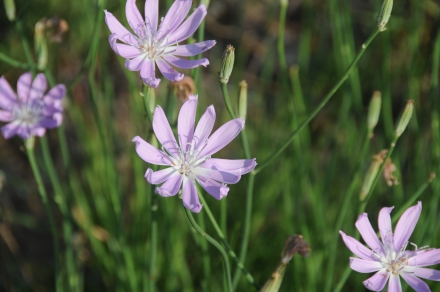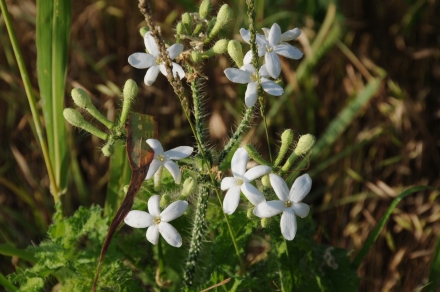At 8:30 this morning, I walked and drove to the far field. Smiling at wild mustang grapevines that yield monarch butterflies along the fence row, I hiked with camera in the grove along Salt Creek. The creek runs water despite the lack of rain for over a month. Squall lines last evening bypassed the ranchito, dumping hail and rain in Fort Worth, sixty-seven miles away to the east and in Cisco, forty-five miles to the west. Wine Cup clearing, as I now call it, bears Wine Cups this Spring. I saw none last year. In the photograph above, the Wine Cups are on the right side of the clearing. They have cool shade from the oak and elm and the creek runs nearby that brings the ambient temperature down a few degrees.
Names have been given, I am sure, to places on the ranchito before I came, but they have not been passed down. (There has been only one owner previous to me besides the Venable family that settled larger sections of land in the surrounds.) I give a name first by location: near field, far field, arena pasture, barn pasture, etc., but then when an object or landform becomes prominent, like Pecan Tree or Wine Cup, I name the space, giving it animation and fixing the impression. I have no crew to direct into the pastures, but when I refer to The Grove or Pecan Tree Pasture, friends and family know where that is, associating flora and fauna with location, and ambiguity disappears.
Two-years ago, I discovered one or two Wine Cups in the grove, up from the creek, in a private place for this blossom. Today, eight blossoms of Wine Cup or Poppy Mallow emerged from the same location. Eight Wine Cups are not a bell weather of climate change, but rather, I suspect, a change due to fallowing, allowing the flowers to replenish. Green grass and tall trees abound about the Wine Cup’s private place. I find no Wine Cups at other locations on the ranchito although I continue to search.
I find Trailing krameria or Prairie sandbur in only two places on the ranchito, both on the knoll where the house sits. This is a delicate plant and can be missed and mowed under if one is not careful. It lies along the fence line between the house and front pasture and, secondly, has emerged on a terrace to the southeast. I find archeological evidence of hearth and tool making about the ranchito and I wonder if earlier inhabitants or migrants saw this plant. I presume so and know it must have some medicinal properties?
The stems of Skeleton Plant are rigid, attached at obtuse angles, like a skeletal frame. The flower stalk and blossom are tall, some two feet. These plants are more prolific this year than two years ago. Here is a larger picture of the Purple Dandelion with yucca blossoms. I cultivate neither. Both emerge wild.
In the far field I have Bull Nettle. It has medicinal properties, but is quite painful to be brushed against. As a boy, I got a painful lesson in ‘trying’ to pick its blossoms. I have a collector in Wisconsin to whom I will send a few with warning labels this Spring.
No. 31 is Common Yarrow.
The pastures are browning here and towards San Angelo and Mexico I am told by ranchers more desert appears. Grass fires have been erupting this last week between here and Abilene. Yet, the diversity of nature here on these 53 acres of my ranchito shows both browning pastures and a creek that runs water with moss growing on its banks. Brown and green, primary colors of nature, intermingle and birds continue to sing despite the fear I have that a climate shift has come and the green will dwindle until next year’s Spring rains. I may be right; I may be wrong. As the ancients said, We shall see what we shall see.
Related articles
- Olivetti and Flowers of Flying Hat (20-24) (swamericana.wordpress.com)
- Yucca morning (swamericana.wordpress.com)

























You are so right, we shall see what we shall see. Enjoying learning about the ranchito’s wildflowers. Such variety.
Thanks, Annie. I have some sunflowers and thistles to work on now.
Queen Anne’s Lace was one of the few familiar flowers when I first moved to Texas – it was plentiful in Iowa. The wine cups are a favorite, like the evening primrose. When I learned about the mallow family, I had one of “those” revelations that come to us – “marsh mallow” is more than a sweet confection!
I heard a mention this week that “they” are saying we’ll have more nearly normal rains in the eastern part of the state this summer, but still tending toward dry in the west. It seems to me you’re about on the “dividing line”. What is certain is that we’re two weeks without rain now, too. It either will or it won’t – another way of making your point.
It either will or won’t — I love it! Hope you and I get the rains.
I just made my morning check of the weather radar – looks like for you, it not only “will”, it “is”! I’m happy for you – they say we may get some, too.
Right. When I left the ranchito at 5:40 this morning it was just beginning to rain and it rained all the way to Abilene. It really ‘is.’
Hello Jack, it’s so interesting to see all those wild plants in your place. Thanks for the tour. The wine cup is so pretty, and it must be good for you to see it coming up again. First time I see the trailing crameria with the pretty flowers, the skeleton plant is so elegant, the bull nettle stings like the stinging nettle. It is so great to see how it looks in another country. We’ve got some excellent communication now.
The only one plant I know from DK is the wild carrot or Queen Anne’s Lace, which is such a fitting name – it looks like the finest lace. It was once a very useful plant, the dried roots were used for coffee surrogate not so long time ago, and in the old days they dyed butter and cheese with it. It was also used against night-blindness and much more. ( If you like then I’ve got a post about it on Thyra, it needs to be extended though).
Thank you for sharing your wonderful place with us.
Grethe ´)
Grethe, I was not aware it had been used for coffee. Thank you for sharing. I must come over and read your post on the Lace. Yes, we have some good communication!
This is a nice way to learn about the flowers. I never realized nettles were in the US, I’ve only come up against them (literally) in the British Isles. I’ll have to keep my eyes open when I’m down that way…
Oh, be sure to do so. Even when you brush against them with Levis on, the needles penetrate and cause stinging pain. Yes, be careful. Thank you for your comment. So, you literally came up against them! Then, you know.
Beautiful! And with names too! You did great.
The Wine Cup looks like what *I* call butter cup. Yet, a buttercup is bright yellow. The flower of which I speak grow alongside our highway and ditches. It also grows along side our property. Except what we have is pale pink with blue tinges which grows lighter as it matures. It is not this gorgeous burgundy color – which makes this flower outstanding. What I see locally appears to be somewhat larger than what you picture. If you were to give measurements (or guesstaments), would be great.
Now, after doing some browsing, I’m puzzled. Don’t know *what* this local flower is!! ha!
In browsing, I came across this URL. You might find it interesting.
http://davesgarden.com/guides/pf/showimage/199750/
The blossom is about 1.5 inches in diameter, very small, hard to see amongst the grass.
Jack, your purple dandelions are lovely! That is a great photograph of the yucca and dandelions. You present your ranchito so delightfully with your names like “Wine Cup clearing” and beautiful photography.
Rubia, thank you! I really like the purple dandelions. I wonder if they appear out where you live? I looked out this afternoon and they are closed, the blossoms so very delicate and purple.
Oh heck,
Another wildflower that I miss from my Texas days! However, for the record, we have the first blooms from cacti just opening here in the desert–and it’s the wine cups! Deep fuschia red. Next, later this month, we’ll have the bright pink cacti flowers, all colors from palest pink to deep pink, and the next band are the peach and flesh-colored flowers of a different species. May and June are always spectacular for flowering cacti in the Utah desert.
Caralee
Caralee, how I envy your various colors of cacti. Just beautiful. If you can and want to, send me some pics, send us all some pics. Flesh-colored flowers — how exotic.